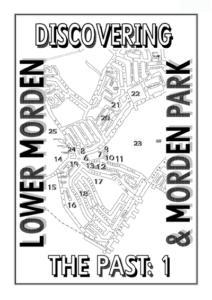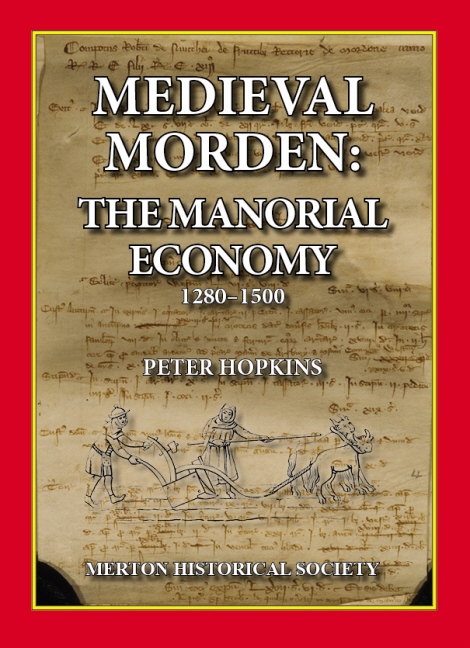Author Archive: Peter Hopkins
Life at the Cranmers, Mitcham, before the 1914-18 War
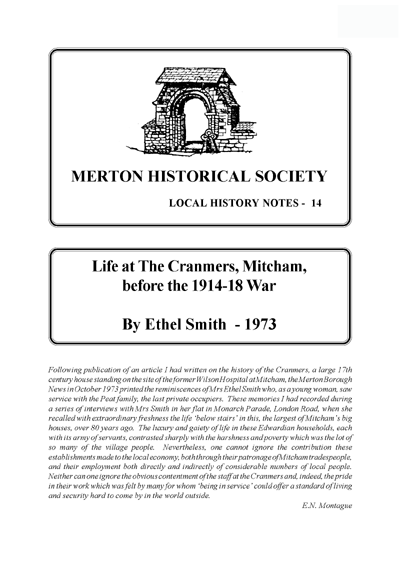
The Cranmers was a large 17th-century house standing on the site of the former Wilson Hospital at Mitcham. Mrs Ethel Smith, as a young woman, saw service with the Peat family, the last private occupiers.
These memories were recorded by E N Montague in 1973 during a series of interviews with Mrs Smith in her flat in Monarch Parade, London Road, when she recalled with extraordinary freshness the life ‘below stairs’ in this, the largest of Mitcham’s big houses, over 60 years before.
Lord Monson’s Schooldays:
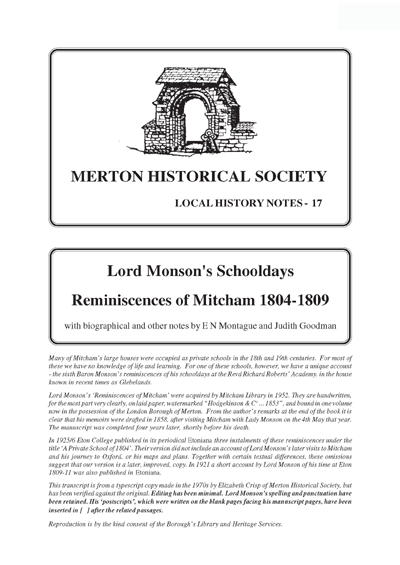
Reminiscences of Mitcham 1804-1809
Many of Mitcham’s large houses were occupied as private schools in the 18th and 19th centuries. For most of these we have no knowledge of life and learning. For one of these schools, however, we have a unique account – the sixth Baron Monson’s reminiscences of his schooldays at the Revd Richard Roberts’ Academy, in the house known in recent times as Glebelands.
Many of Lord Monson’s Mitcham schoolfellows later became prominent in politics, the church and society. His memoirs give interesting glimpses of some great men when they were boys.
Lost Common Lands – Merton Common
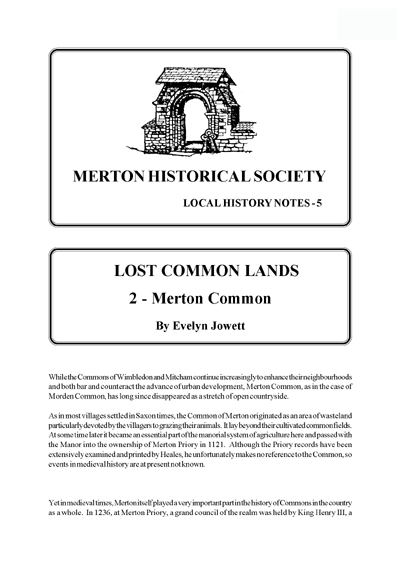
An account of how Merton Common was enclosed by means of a private Act of Parliament in 1816.
This article first appeared in the Merton Borough News as part of the series ‘The Merton Story’ on 15 and 22 March 1974. Miss E M Jowett , Vice President of the Society, died in August 1990.
Lost Common Lands – Morden Common
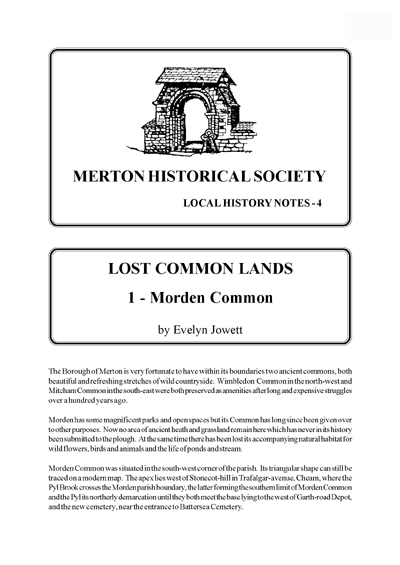
Morden Common, always small, shrank throughout the 19th century. The last open land was lost in the 1920s.
This article first appeared in the Merton Borough News as part of the series ‘The Merton Story’ on 8 March 1974. Miss E M Jowett , Vice President of the Society, died in August 1990.
Lower Morden and Morden Park
In producing this booklet of 25 double-spread pages, Peter offers us a rich source of material, most of which appears in print for the first time and is the result of a great deal of original research into a wide range of documentary sources. A general survey of Morden parish from AD 1 to the year 2000 leads the reader into a detailed account of 20 locations into which Peter has divided Lower Morden. The whole is illustrated with 47 maps and 39 photographs old and new.
Manorial Documents
Translations of most of these Morden manorial documents, including court rolls and more than 100 account rolls are being added to this website and can be viewed or downloaded.
Medieval freehold properties in Morden
Surrey History Centre holds documents that trace the descent of some freehold properties in Morden from the mid-15th century until 1602. The earlier history of these properties can be discovered from entries in the manorial court rolls.
Medieval Morden: Landscape and Landholding

The second of three planned studies by Peter Hopkins into various aspects of medieval life as revealed through the surviving records, this volume seeks to reconstruct the changing topography of medieval Morden and investigates the various ways that property was held and transferred over the centuries..
Medieval Morden: Neighbourhood and Community
Morden is now a suburb within the London Borough of Merton, its only claim to fame being as a terminus of London Underground’s Northern Line. However, only a century ago it was still a small agricultural community and its medieval origins were still in evidence. Although almost nothing now remains of its medieval structures, we are fortunate that a considerable archive survives, detailing its layout and its day-to-day life.
Medieval Morden: Neighbourhood and Community
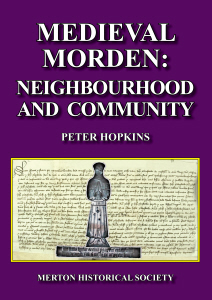 This study focuses on social interaction and community dynamics, in the light of the demands made of Morden’s inhabitants by the State, by the Church and in particular by Westminster Abbey as manorial lord, but also by the local community and the family. Most of the information comes from manorial court rolls, and the role and processes of the manor court are examined at the outset. Other chapters consider differences in status and in wealth, the role of credit, the evidence for conflict and cooperation and for the exercise of power and influence by local people. From brewers and bakers to priests and parishioners, this book explores the strengths and the tensions that worked together to form and to challenge a sense of neighbourhood and community in Morden especially in the centuries following the Black Death.
This study focuses on social interaction and community dynamics, in the light of the demands made of Morden’s inhabitants by the State, by the Church and in particular by Westminster Abbey as manorial lord, but also by the local community and the family. Most of the information comes from manorial court rolls, and the role and processes of the manor court are examined at the outset. Other chapters consider differences in status and in wealth, the role of credit, the evidence for conflict and cooperation and for the exercise of power and influence by local people. From brewers and bakers to priests and parishioners, this book explores the strengths and the tensions that worked together to form and to challenge a sense of neighbourhood and community in Morden especially in the centuries following the Black Death.
This volume also includes a substantial biographical register of over 1000 individuals who appear in the surviving records and who played their part in creating medieval Morden’s communal life.
Medieval Morden: The Manorial Economy
Peter Hopkins began his studies of Medieval Morden more than 20 years ago, by copying, transcribing and translating any and every medieval record relating to Morden that he could find.
Meet Betty
Meet Gladys
Click on the Audio Clip to hear Gladys’s story.
Meet Madeline
Memoir of Priscilla Pitt, by John Marsh Pitt 1899
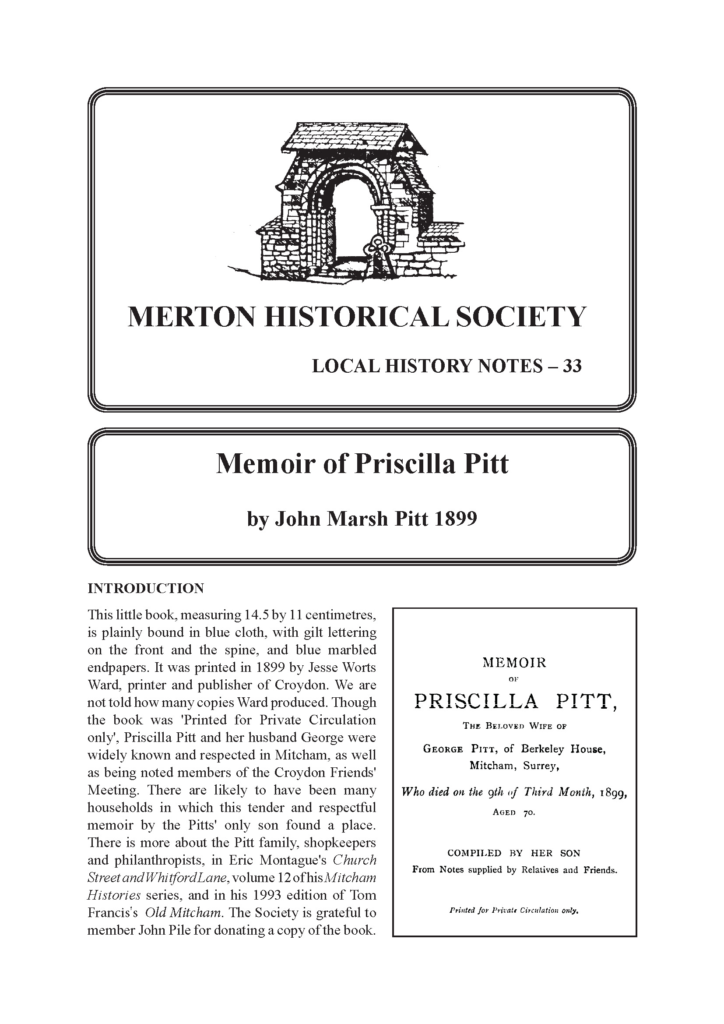
John Marsh Pitt produced this Memoir to his mother shortly after her death in 1899, and the Society is grateful to member John Pile for donating a copy of the book for reproduction. ‘This little book, measuring 14.5 by 11 centimetres, is plainly bound in blue cloth, with gilt lettering on the front and the spine, and blue marbled endpapers. It was printed in 1899 by Jesse Worts Ward, printer and publisher of Croydon. We are not told how many copies Ward produced. Though the book was ‘Printed for Private Circulation only’, Priscilla Pitt and her husband George were widely known and respected in Mitcham, as well as being noted members of the Croydon Friends’ Meeting. There are likely to have been many households in which this tender and respectful memoir by the Pitts’ only son found a place. There is more about the Pitt family, shopkeepers and philanthropists, in Eric Montague’s Mitcham Histories 12 Church Street and Whitford Lane, and in his 1993 edition of Tom Francis’s Old Mitcham‘.
Memories of a Morden Lad 1932-1957
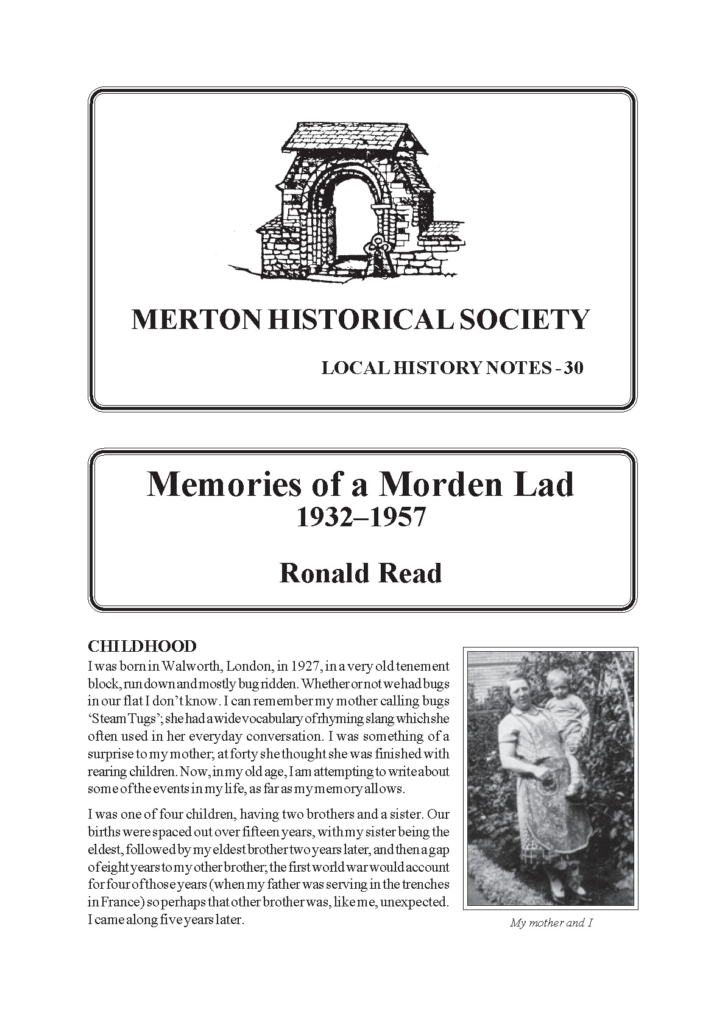
Local History Notes 30: by Ronald Read
Ronald Read recounts his childhood and wartime memories of growing up on the Morden part of the St Helier estate in the 1930s and 1940s. He then takes us to post-war Europe following his call-up to the army in 1945. His return to civilian life in Morden in 1948 was interrupted by 18 months spent in sanatoria in Waddon, Southbourne and Cheam, after he was diagnosed with TB in 1952. Mr Read expresses himself bluntly, and some readers might be offended by his language, but his account is a valuable, and fascinating, record of his life and experiences at home in Morden and further away. At 72 pages, this is our most substantial Note yet.
Memories of Lower Morden
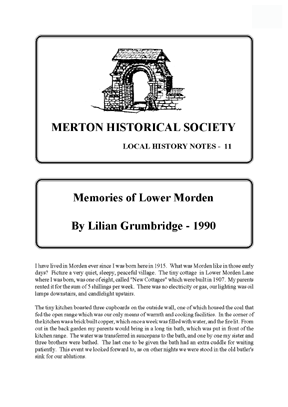
Lilian Grumbridge was born in one of the ‘New Cottages’ in Lower Morden Lane in 1915, and lived there until her marriage, when she moved to her present home in nearby Hillcross Avenue. Her memories of life in this tiny rural area, with its three farms, contrasts with life in the area today.
Memories of Morden between the Wars
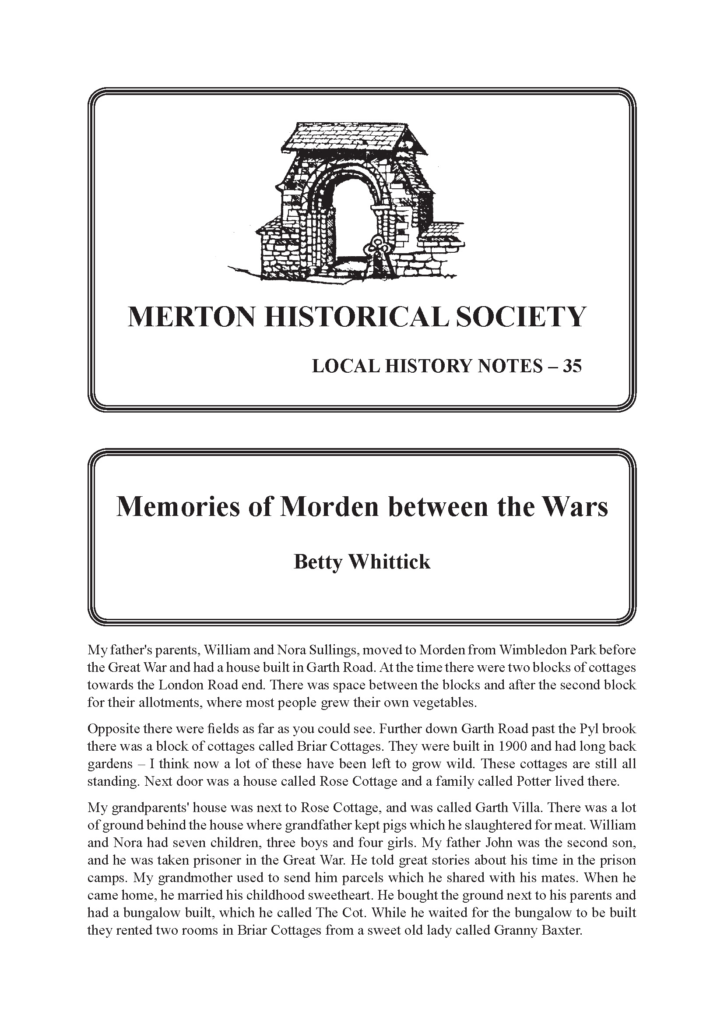
Betty Whittick relives her childhood in Garth Road. Those who heard Betty at our September 2012 ‘Chat Show’, or have listened to snippets on our website, have already had a foretaste of these fascinating reminiscences.
 MERTON HISTORICAL SOCIETY
MERTON HISTORICAL SOCIETY 